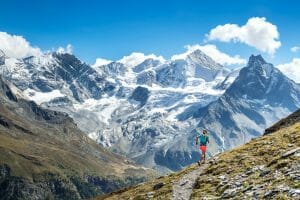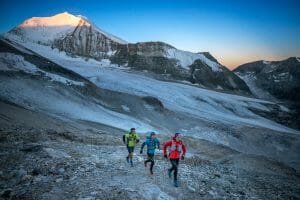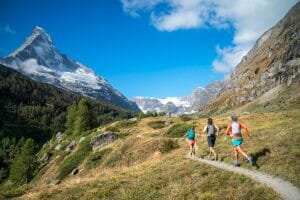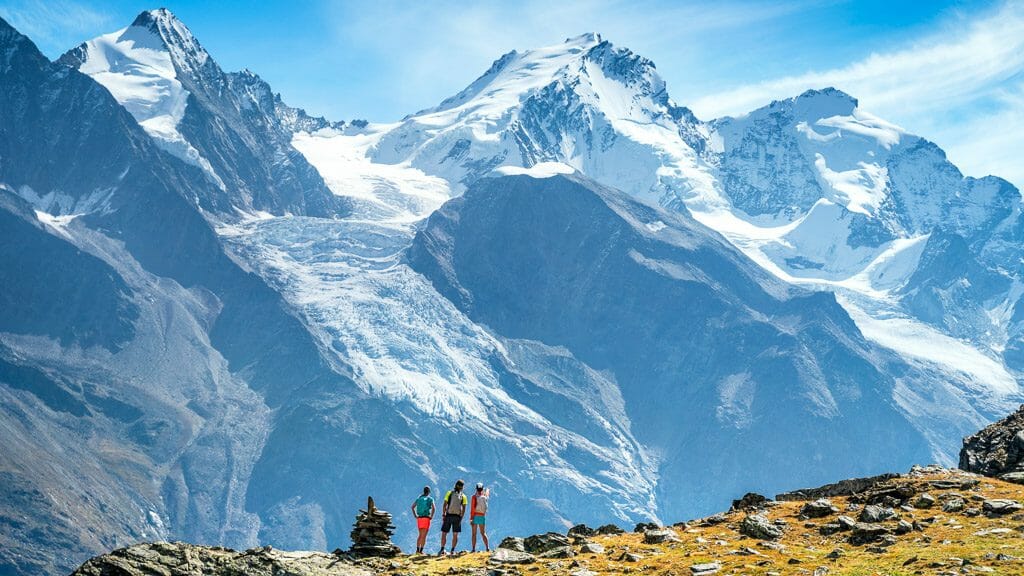“That was the best trail I’ve ever run!” We each made that claim more than a few times during the five months in 2017 we spent running for our trail running guidebook, Run the Alps Switzerland. Most often, we’d just stepped off another trail run in the Valais region.
-by Dan Patitucci and the team at ALPSinsight’s Elevation: The Alps Trail & Peak Running Resource
We’ve spent six years in the Italian Dolomites, ran around Patagonia, splashed through Iceland, crossed 5,000-meter Himalayan passes, and traced routes all over the Rockies and Sierra Nevada. And in the last 20 years, we have explored nearly every corner of our home mountains, the Swiss Alps.
Switzerland’s Valais region has become one of our favorite places to run for several reasons. Thanks to a gift from the geologic gods, the trails tend to be smooth, ground gneiss without roots to trip over. Since you aren’t staring at your feet, you have time to look around at one of the Alps’ most dramatic landscapes, which is most likely wildflower-covered green hillsides leading up to glaciers flowing around perfectly formed peaks. Plus, there is the hut system, which allows traveling through it all without the need to carry much gear. It’s a perfect package to accommodate all sorts of mountain fun.

Nearly half of the 30 runs we present in our book happen to be in the Valais. When we started to consider what new runs we could squeeze in the following summer, we noticed that on a map there was a dashed line of runs we’d already done crossing a similar line as the summer Haute Route hiking trail.
“What if we connect a bunch of our Valais runs and make one big tour?” I suggested.
Janine, the map wizard and creator of all our running tours perked up. “I know exactly where to go so we can add more great trails!”
Kim, our partner at ALPSinsight, smiled wide and without hesitation announced, “We can call it the Via Valais.”
And so we did.
Introducing the Swiss Alps Trail Running Grand Tour: The Via Valais Verbier to Zermatt
Our goal was to connect two of the most famous Swiss mountain towns, Verbier and Zermatt. This we did both for the name, and because we knew that the trails between the two were prime terrain with perfectly situated huts and villages for overnight stays. Plus, it seemed like the only way to top eight days of exquisite trail running was to run along the base of the Matterhorn on the final day, before dropping off the trails and into Zermatt.
All the necessary ingredients were in place, we just had to find the best linkups. Our strategy was to parallel the Haute Route trail and occasionally join it. But, instead of using the Haute Route’s daily program of steep ups and steep downs, we’d stick to an independent line of singletrack contouring in and out of the deep valleys.
To spice things up for the exceptionally fit runners, Janine included a “Bonus Peak” for each stage. These are short detours from the main Via Valais trail to access summits. Some Bonus Peaks are quite alpine, like the Pigne de la Lé, but never require more than easy scrambling.
For what we call the Via Valais Queen Stage, we include the 3,610-meter Barrhorn, the Alps’ highest summit with an official trail to the top. Because of our decision to include this peak, the trail crosses a steep alpine pass, the Schöllijoch, and descends to a small glacier (crevasse free as of 2018), before dropping 2,000 meters to the next valley. This passage, probably the single most beautiful and difficult day, was another key to making the Via Valais a unique line, differentiating it from the Haute Route.
It took us four goes to find the right start, then one big push all the way to Zermatt before we had it—the Swiss Alps’ first trail running grand tour! A nine-stage, 225-kilometer, and 14,000-vertical-meter route that, thanks to the hut system, can be done with only 15-liter running packs.
We are thrilled to release the discovery of what we feel is the best trail run, anywhere. And we have a big goal: to establish the Via Valais as an iconic tour that tops every trail runner’s life list. Let’s do this!




Preparing for the Via Valais
To maximize the experience, arrive prepared for nine days of running through the mountains. This means considering all the logistics, choosing the right gear to be as light as possible, and especially being fit for the journey. While no single day is very hard, nine days of averaging 25 kilometers with 1,500 meters of gain is going to take its toll.
Runners should arrive in Verbier mountain strong, which means being tough more than it means being fast. One consistent thing I see is American runners arriving in the Alps strong and fit, only to struggle with the Alps’ relentless vertical.
Since the Via Valais starts and finishes high, it does not have any single climb of more than 900 meters. Instead, it rolls along on medium-size climbs of about 500 meters, which, for me, is more tiring than one big effort. There is, however, that descent of 2,000 meters on day 7, which inflicts some serious damage to tired legs and a taxed aerobic system.
Since the Via Valais follows “runnable” trails for much of its distance, your fitness level should strike a balance between being able to actually run long sections while hiking the steeper climbs. For some people, the running will be the tough part thanks to the weight you’ll be carrying. For the solid runners, walking the climbs may be more punishing.
Regarding pack weight and what gear to use, we address these topics on our Via Valais Pack & Prepare page.
The Via Valais is hard, but it is also very attainable with the proper preparation for the required demands. Part of the fun is the planning and preparation—the logistics, the gear, the strategy, and especially the training. The team at Uphill Athlete understands the requirements and can best help prepare runners for what we sincerely believe is going to be a great trail running experience.
Uphill Athlete Training Tips
If this challenge appeals to you—and what mountain lover wouldn’t want to run though such incredible scenery?—let’s talk about the best way to make it even more enjoyable.
At Uphill Athlete we’ve proven thousands of times over with climbers, ski mountaineers, and trail runners—from rank beginners to some of the world’s best—that well-designed training based on proven training principles works wonders.
The Via Valais will tax most trail runners, but it is not out of reach, provided you are willing to apply yourself to focused preparation. To help guide your training, we’ve created a 16-week training plan designed to address the specific demands of this spectacular tour. It is engineered to prepare you for the massive elevation gain and loss each day.
The Big Vert Ultramarathon Training Plan works best for those with ready access to mountainous training grounds. However, it can also be completed by runners living in the flatlands who are willing to put in their time on a steep treadmill using specific workouts we’ve used for years to help athletes become more durable and fatigue resistant on mountain terrain.
All photos by Dan Patitucci.

